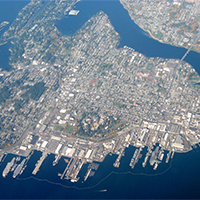A random walk down Main Street
Abstract
US suburbs have often been characterized by their relatively low walk accessibility compared to more urban environments, and US urban environments have been char- acterized by low walk accessibility compared to cities in other countries. Lower overall density in the suburbs implies that activities, if spread out, would have a greater distance between them. But why should activities be spread out instead of developed contiguously? This brief research note builds a positive model for the emergence of contiguous development along “Main Street” to illustrate the trade-offs that result in the built environment we observe. It then suggests some policy interventions to place a “thumb on the scale” to choose which parcels will develop in which sequence to achieve socially preferred outcomes.
Downloads
References
Dill, J. (2004). Measuring network connectivity for bicycling and walking. In Joint Congress of ACSP-AESOP. Retrieved from http://reconnectingamerica.org/assets/Uploads/TRB2004-001550.pdf
Ewing, R., R. Pendall, and D. Chen (2003). Measuring sprawl and its transportation im- pacts. Transportation Research Record: Journal of the Transportation Research Board 1831(1), 175–183. doi:http://dx.doi.org/10.3141/1831-20
Galster, G., R. Hanson, M. R. Ratcliffe, H. Wolman, S. Coleman, and J. Freihage (2001). Wrestling sprawl to the ground: defining and measuring an elusive concept. Housing policy debate 12(4), 681–717. doi:http://dx.doi.org/10.1080/10511482.2001.9521426
Gillham, O. (2002). The limitless city: a primer on the urban sprawl debate. Island Press. Harvey, R. O. and W. A. Clark (1965). The nature and economics of urban sprawl. Land Economics 41(1), 1–9.
Hess, D. B. (1997). Measures of connectivity. Places. Retrieved from: http://escholarship.org/uc/item/9599t9f1
Hess, P. M., A. V. Moudon, M. C. Snyder, and K. Stanilov (1999). Site design and pedestrian travel. Transportation Research Record: Journal of the Transportation Research Board 1674(1), 9–19. doi:http://dx.doi.org/10.3141/1674-02
Moudon, A. V., P. M. Hess, M. C. Snyder, and K. Stanilov (1997). Effects of site design on pedestrian travel in mixed-use, medium-density environments. Transportation Research Record: Journal of the Transportation Research Board 1578(1), 48–55. doi:http://dx.doi.org/10.3141/1578-07
Sutton, P. C. (2003). A scale-adjusted measure of “urban sprawl” using nighttime satellite imagery. Remote Sensing of Environment 86(3), 353–369. doi:http://dx.doi.org/10.1016/S0034-4257(03)00078-6

Copyright (c) 2016 Tema. Journal of Land Use, Mobility and Environment

This work is licensed under a Creative Commons Attribution 4.0 International License.
Authors who publish in this journal agree to the following:
1. Authors retain the rights to their work and give in to the journal the right of first publication of the work simultaneously licensed under a Creative Commons License - Attribution that allows others to share the work indicating the authorship and the initial publication in this journal.
2. Authors can adhere to other agreements of non-exclusive license for the distribution of the published version of the work (ex. To deposit it in an institutional repository or to publish it in a monography), provided to indicate that the document was first published in this journal.
3. Authors can distribute their work online (ex. In institutional repositories or in their website) prior to and during the submission process, as it can lead to productive exchanges and it can increase the quotations of the published work (See The Effect of Open Access)
